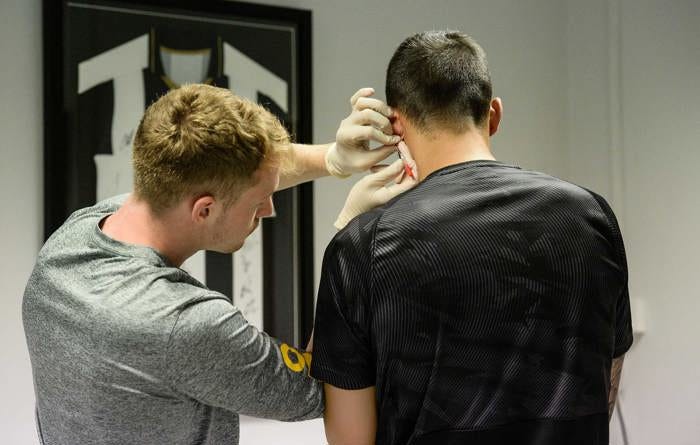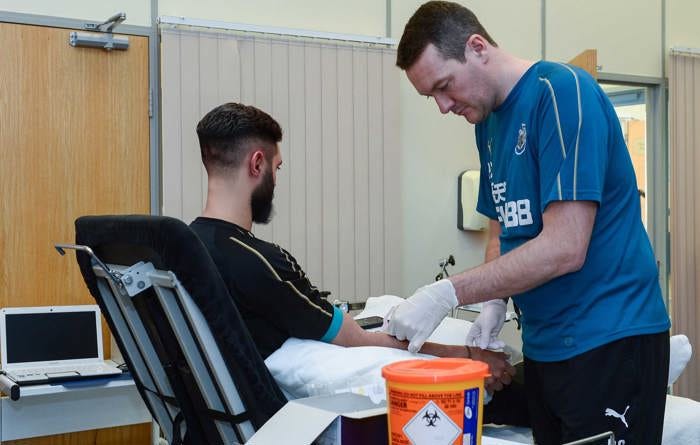🔎📈 Upside Featured Post: Making the Invisible, Visible: How Internal and External Loads Change Movement Behaviors to Drive Injury Risk
This article was originally posted on FIPRO here.
By Dr John Kiely
The financial burden of injuries in professional football has reached new heights. According to the recent Howden 2023/24 Men's European Football Injury Index report seasonal injury costs again rose across the top five men's European leagues, this time by five percent to reach €732.02 million.
Collectively, over the last four seasons, clubs in the top five European men’s leagues have accumulated 14,292 injuries, resulting in injury-related costs of €2.3 billion. This year’s Howden report is released as concerns over fixture congestion grow. The alarming increase in injuries confirms the growing mismatch between the increasing workload demands placed on players and their injury resilience. Notably, the release of the Howden report follows shortly after the formal complaint lodged to the European Commission against FIFA by player unions and national leagues.
Competition organisers and regulatory bodies bear responsibility for protecting players' health, via the implementation of appropriate safeguards increasingly required around competition scheduling, recovery periods and international travel. Additionally, individual clubs must also act, within existing scheduling constraints, to optimise player management and prioritise player health. One strategy that lies within clubs' control is the optimisation of player load management. A necessary step towards this objective is to upgrade and update our understanding of how different stressors – different sources of imposed load – combine to diminish performance potential and elevate injury risk.
2023/24 Men's Player Workload Monitoring Report
The report highlights the burden on men's players involved in multiple international tournaments that endangers their welfare, performance and career prospects.
Understanding the Bi-directional Nature of Internal and External Loads
During match-play, intense physical activity inflicts micro-traumas to muscle, bone, and connective tissue structures. Microtraumas are small, often microscopic injuries to bodily tissues occurring due to dynamic activity and/or repetitive stress. Such micro-traumas are normally harmless. However, if they accumulate — driven by excessively intense movement and inadequate recovery — brain and body reflexively initiate cascades of remedial protective responses. Blood flow increases as blood vessels dilate. Inflammatory agents flood the area. Damaged locations swell. Neutrophils and macrophages clear away cellular debris. Antioxidants mobilise to counter excessive oxidative stress and restore redox homeostasis. Satellite cells migrate to damaged areas to aid in repair and regeneration. These and multiple other allied biochemical adaptations blend to create an enhanced local environment, optimised for healing and adaptation.
Importantly, accumulating micro-traumas also increase tissue sensitivities. Players subsequently, consciously and subconsciously, change movement patterns to unload sensitised regions, and change their movement choices and decisions to avoid situations likely to further challenge already compromised tissue structures.
How Excessive Load Impacts Movement
Intense activity drives micro-trauma and subsequently changes internal environments. These localised biochemical shifts disrupt players' capacity to move in a coherent, coordinated manner.
Movement dysregulation is evident at both the micro- and macro- extremes of the movement control continuum. At the micro-level, communication clarity between brain and body is disrupted. Well-practiced movements become irregular. Movement smoothness deteriorates. Movement errors accumulate. Microtraumas increase. Injury risk intensifies.
At the macro-level, in the face of mounting fatigue, discomfort, distress, and cognitive overload, players' perceptions of their current abilities change. Players' ability to accurately judge capacities and limitations become dangerously skewed. Players' perceptions of whether specific movement options are safe or risky, become unreliable. Players begin to make more erratic decisions. Players deviate away from habituated movement solutions in favour of less frequently executed, less engrained, less conditioned and less polished alternatives. Inevitably, errors accumulate. Mechanical loads amplify. Micro-traumas increase and a dysfunctional feedback/feedforward doom loop gathers momentum. The player either rests, reduces their workload, or ultimately breaks (physically or psycho-emotionally).
As players navigate through increasingly challenging circumstances, the cumulative effects of these altered movement dynamics combine with other stressors to create a perfect storm of injury risk factors.
Why the match calendar is hindering high-performance and threatening player health
How Internal and External Loads Conspire to Escalate Injury Risk and Severity
Consider a player facing a congested schedule: consecutive back-to-back games every three days, travel across multiple time zones, media stress, selection pressures, disrupted sleep, and overlapping competitions inhibiting adequate recovery. This blend of external loads and internal psycho-emotional challenges creates a perfect storm, conspiring to:
Drive inflammation
Intensify tissue sensitivities
Deplete precious energetic and biochemical stores
Excessive metabolic disturbance
Intensify perceptions of fatigue and discomfort
Collectively, these outcomes combine to amplify the players stress response; consume neural processing capacity; impede neuromuscular communications; diminish movement confidence and competence and erode decision-making clarity.
This maliciously spiralling cycle of ever-increasing load and compromised coordinative fluency leads to:
Increasing tissue micro-traumas
Diminishing movement capacity and coordination
Escalating probability of injury
Monitoring Movement Behaviours: A New Frontier in Injury Prevention
Theoretically, in any given situation, players are free to select from a near-infinite range of viable movement options. Critically, however, these movement options are not all equal.
Under physical, mental, emotional and time-pressured conditions, we don’t pause to reflect while we sift through our full repertoire of potential movement solutions. Instead, we reflexively gravitate towards solutions that we have successfully deployed in the past. Movements that worked. Movements that didn’t hurt. Movements we have executed many times. Movements that have been extensively practiced and are now highly efficient.
Our selection of movement options is heavily biased, consciously and subconsciously, by our personal set of preferences, idiosyncrasies, predispositions and prior movement and injury histories. How we moved in the past dictates how we move in the present, and how we are likely to move in the future. We are creatures of habit. Our movement habits evolve, invisibly, across a lifetime of training, competition and personalised injury histories.
But recent technological evolutions have made the invisible, visible. The signature movement sequences that shape players' movement behaviours can now – thanks to advanced optical tracking systems and interpretable machine learning techniques – be captured and statistically mapped. More specifically, and for the first time, new technological and methodological innovations enable the identification, quantification, and characterisation of players' movement behaviours – the hidden sets of preferences, biases, aversions, predispositions and practiced-embedded efficiencies
Notably, detailed mapping of players movement signatures reveals, perhaps surprisingly, that these movement behaviours demonstrate remarkable consistency and structural resilience, both within individual games and across multiple games. Perhaps even more surprisingly, in analyses conducted by bio-analytics company Orreco, when these movement behaviours deviated outside their normal habituated ranges the incidence of injury rose dramatically.
So dramatically that these analyses successfully predicted 85% of elite hamstring injuries, with an 86% specificity (indicating an impressively low incidence of false alarms).
Pictures: Orreco testing
Such unprecedented accuracy can provide coaches and support staff with critical decision-making information and insights. Clearly, more research is needed to validate these methods. Nevertheless, these initial results are encouraging and suggest that tracking movement behaviours may be a crucial, albeit currently ignored, indicator of elevated injury risk.
What Can We Do?
The optimisation of load management processes to mitigate injury risk demands a multi-faceted approach:
By adopting a holistic approach to player management, informed by the insights provided by biomarkers and advanced tracking systems, we can surface previously unavailable, yet actionable, insights serving to optimise performance and protect player health.
Conclusion
As confirmed by the 2023/24 Howden report, the financial impacts of injuries are immense, and increasing at an alarming rate. Understanding and addressing the complex interplay between loads and movement behaviours may reduce this burden; thereby enhancing player welfare and performance potential across football ecosystems.
With elite young players playing more matches than ever before, the future of injury prevention depends on making the invisible visible. While the current match and calendar demands placed on leading players are unsustainable, sports science can play a key role in protecting player health and wellbeing. By revealing the invisible drivers of injury risk, we can work to optimise player management, limit unnecessary training, reduce injury incidence, extend career longevity and ultimately safeguard players long-term health.
Author: Dr John Kiely, Associate Professor, Human Performance and Innovation, University of Limerick, Ireland
Dr John Kiely is an expert on performance and innovation, having worked across multiple global events including the FIFA World Cup, Rugby World Cup, Olympic & Paralympic Games, and the IAAF World Championships. Dr Kiely oversees doctoral candidates working within high-performance sport, including performance staff from EPL, La Liga, Serie A, NFL and other leading leagues.
Supporting Authors
Dr Brian Moore, Co-founder & CEO, Orreco
Prof John Newell, School of Mathematical and Statistical Sciences, University of Galway, Ireland
Prof Charlie Pedlar, Faculty of Sport, Applied Health and Performance Science, St Mary's University Twickenham, U.K.
You may also like our other Upside studies:
🔎📈 Upside Study: The Athletic Intelligence Quotient & Performance in the NBA
Title: The Athletic Intelligence Quotient and performance in the NBA
🔎📈 Upside Study: The Impact of Sleep Interventions on Athletic Performance: A Systematic Review
Title: The Impact of Sleep Interventions on Athletic Performance: A Systematic Review










